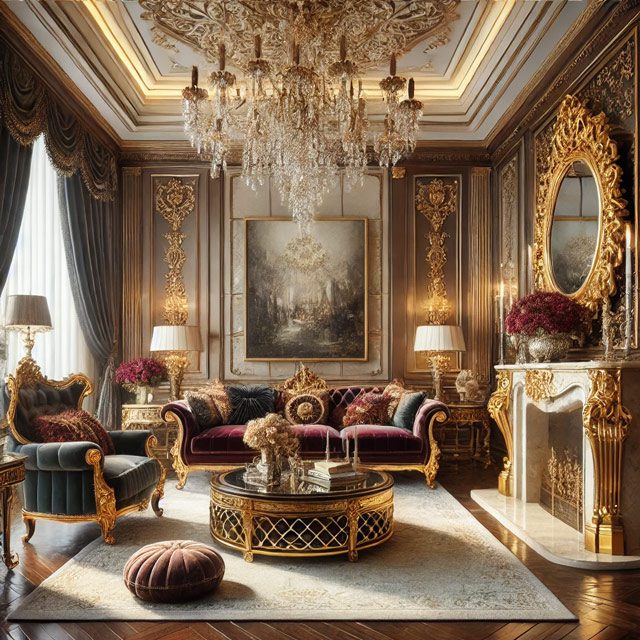
In a world where minimalist decor is king, draping your home in luxury feels like breaking the rules. Sure, everyone talks about “less is more,” decluttering, and sticking to neutral tones, but what if that’s not your vibe? What if you crave velvet armchairs, crystal chandeliers, and oversized oil paintings? In an era that pushes simplicity, going all out with rich decor could be the boldest statement you can make.
You see, decorating like a rich person isn’t about trying to fit in with the ultra-wealthy. Instead, it’s about defying modern trends, expressing your personality, and giving the middle finger to those who say your home should look a certain way. In fact, leaning into opulence could be the ultimate act of rebellion. Let’s break down why.
The Minimalism Obsession: Why We’ve All Gone ‘Humble’
Over the last decade, minimalism has taken over. Pinterest, Instagram, and every home design magazine have preached the same message: get rid of excess, keep it simple, and stick to neutrals. Think white walls, Scandinavian furniture, and barely-there decor. It’s clean, sure, but is it you? Or is it what we’ve been told should be us?
Minimalism has deep roots. It’s tied to modernism, which began in the early 20th century as a reaction to the overly decorated, cluttered spaces of previous eras. People wanted a fresh start, a break from the fussy Victorian look. Fast forward to today, and we’re still pushing that clean slate—but now, it feels more like a mandate than a choice.
Part of this push for simplicity comes from the modern middle class. Millennials, in particular, are bombarded with messages about decluttering from the likes of Marie Kondo, who sparked a global “tidying up” craze. The message is clear: stuff equals stress, so throw it out. But what if you’re someone who thrives on the beauty of bold, intricate, and extravagant decor? Does that make you wrong—or are you just part of a growing group of rebels?
And let’s not forget the underlying classism in this minimalist trend. While minimalism is marketed as “accessible” to all, there’s an unspoken pressure to maintain a level of polish that many simply can’t afford. It’s one thing to have a perfectly minimalist living room with a designer couch and polished concrete floors. It’s another to throw away what you have and then feel bad about replacing it with anything but sleek, overpriced furniture.
The History of Opulence: How the Rich Have Always Decorated
While minimalism may reign today, the rich have never played by these rules. For centuries, the wealthy have embraced opulence as their decor style of choice. In fact, the idea that luxury equals wealth goes back hundreds of years, when royals and aristocrats filled their homes with gold accents, elaborate paintings, and lush textiles.
Let’s look back at the Baroque period, which was all about excess. From the 17th to the 18th century, European monarchs like Louis XIV of France packed their palaces with grandeur. The Palace of Versailles, dripping in gold and surrounded by sprawling gardens, is a perfect example of rich people showing off through decor. It wasn’t just about having wealth; it was about showing it.
In the 19th century, Victorian design continued the trend, with homes filled to the brim with rich, heavy furniture, ornate wood carvings, and detailed wallpaper. The Victorians loved excess, whether in the form of intricate rugs, velvet drapes, or grand chandeliers. Their homes were designed to impress, and the more cluttered they were, the better.
Even in the 20th century, the ultra-wealthy resisted the simplicity of modernism. Think about the Gilded Age mansions in America, like the Vanderbilt family’s Biltmore Estate. These homes were filled with the best that money could buy—massive libraries, marble floors, and decorative moldings that screamed wealth.
Today, we still see echoes of this love for opulence among the super-rich. Tech billionaires and celebrities are the new royalty, and their homes follow suit. Kim Kardashian’s stark, minimalist home may have made headlines, but plenty of other A-listers, like Oprah or Beyoncé, are embracing richly decorated spaces filled with bold art, luxurious furniture, and elaborate lighting fixtures.
Why ‘Rich’ Style Decor is More Accessible Than Ever
Here’s the good news: you don’t have to be rolling in money to make your home look like a millionaire lives there. The democratization of luxury decor has made it easier than ever to add high-end touches without draining your bank account. You can create a lavish space on a budget, and no one will be the wiser.
Take IKEA, for example. You might not associate this Swedish retailer with luxury, but they’ve expanded their offerings in recent years to include velvet armchairs, gold-toned accessories, and marble-look countertops—all at prices most people can afford. Sure, it’s not real marble, but it looks close enough, and for a fraction of the price, it’s a smart investment.
Wayfair and other online retailers have also jumped on the luxury trend. These companies make it possible to buy large, extravagant pieces (think tufted headboards or oversized Persian rugs) at prices that won’t break the bank. The key is knowing where to shop and being willing to mix and match.
Another way to get the luxe look? Thrift shopping. Estate sales, antique stores, and flea markets are filled with hidden gems, from gilded mirrors to plush velvet couches. Sure, it takes some digging, but when you find that perfect vintage piece, it’s well worth the effort. Plus, nothing says “wealthy” like an antique that no one else has.
And don’t forget about DIY. With a little creativity and some YouTube tutorials, you can turn affordable items into luxurious decor. Reupholster an old chair with velvet fabric, spray-paint a cheap metal frame gold, or add faux marble contact paper to a table. These small changes can make a big difference in how a room feels—without costing you thousands of dollars.
The Rebellious Statement: Why Going ‘Rich’ Flips the Script
In today’s world, minimalism is more than a design choice—it’s almost a moral stance. Many people see it as the “right” way to live, equating a clutter-free, simple home with purity, mindfulness, and responsibility. But when everyone’s doing the same thing, where’s the individuality? This is where decorating like a rich person becomes a rebellion.
When you deck out your home with opulence, you’re saying you’re not here to follow trends—you’re here to create your own. You’re rejecting the idea that your home has to look like a picture-perfect, minimalist Instagram post. Instead, you’re embracing the bold, the beautiful, and the over-the-top.
Luxurious decor is more than just a way to fill a room—it’s a form of personal expression. Your home should reflect your personality and tastes, and if that includes a velvet sofa and a crystal chandelier, then so be it. By leaning into rich decor, you’re reclaiming your space and rejecting the pressure to conform to society’s expectations.
And it’s not just about being different. It’s about challenging the narrative that luxury equals waste or excess. When done thoughtfully, rich decor can be just as intentional as minimalist design. It’s about choosing pieces that bring you joy, make you feel comfortable, and show off your personal style. It’s about creating a space that feels right for you, not for anyone else.
Luxury doesn’t have to mean wasteful or excessive. After all, why can’t a velvet chaise and a crystal chandelier coexist with a sustainable lifestyle? The key is to be intentional about what you bring into your home and to mix luxury with ethical, thoughtful choices.
How to Achieve a Luxe Look Without Going Broke
You don’t need to spend a fortune to create a rich-looking home. The secret lies in knowing which key elements to focus on and how to integrate them with your existing decor. A few strategic choices can instantly give your space a luxurious vibe.
Start with textures. Rich materials like velvet, silk, and leather scream luxury. A velvet armchair, silk throw pillows, or a leather ottoman can add an opulent feel to a room without costing you too much. Opt for deep, jewel-tone colors like emerald green, sapphire blue, or ruby red to really elevate the look.
Next, consider your lighting. A chandelier or statement light fixture can transform a space from simple to stunning. You don’t need a crystal chandelier straight out of Versailles—plenty of affordable options mimic that high-end look. Even a well-placed floor lamp with a metallic finish can make a huge impact.
Another trick is to use mirrors and metallics. Mirrors reflect light and create the illusion of a larger, more open space—something often seen in luxurious interiors. Choose mirrors with ornate frames, or even better, vintage ones. Metallic accents, whether in the form of gold picture frames or silver vases, can add a touch of glamour without overwhelming the room.
Faux luxuries are also a great way to get that opulent look without the opulent price. Faux marble countertops, faux fur rugs, and even faux crystal lamps are all affordable alternatives that give off the same vibe as the real deal. Plus, they’re often easier to care for!
Finally, don’t be afraid to mix high and low. Pair a thrifted antique armchair with an affordable couch from IKEA. Layer an inexpensive rug over hardwood floors. The contrast between affordable pieces and one or two statement items can create an effortlessly luxe look.
The Ethics of Opulence: Can Luxury Be Sustainable?
For many, the word “luxury” brings up images of excess, waste, and environmental harm. But luxury and sustainability aren’t mutually exclusive. In fact, there are plenty of ways to create a rich-looking home while still being conscious of your impact on the environment.
One way to do this is by embracing slow design and conscious consumption. Instead of filling your home with fast furniture that you’ll throw out in a few years, invest in high-quality pieces that will stand the test of time. This doesn’t mean you need to spend a fortune. It simply means choosing items that are built to last—whether they’re new or secondhand.
Vintage and upcycled pieces are also a great way to add luxury to your home without contributing to environmental harm. Antique furniture, for example, often comes with the kind of intricate details and craftsmanship that you rarely find in modern, mass-produced pieces. And the best part? These items have already stood the test of time.
There are also plenty of eco-friendly brands offering luxurious home goods. Companies like Avocado Green and The Citizenry create sustainable, high-end decor using ethical production methods and environmentally friendly materials. Whether it’s a handwoven rug or an organic cotton duvet, these brands prove that luxury and ethics can go hand in hand.
The New Rules of Rich Decor
So, what’s the takeaway? Decorating your home like a rich person isn’t about flaunting wealth—it’s about reclaiming your personal style and rejecting the pressure to conform to minimalist trends. It’s about creating a space that feels like you, even if that means breaking a few design rules along the way.
By choosing luxurious decor elements thoughtfully and intentionally, you can make a bold, rebellious statement while still being true to yourself. Whether it’s through high-end textures, vintage furniture, or opulent lighting, your home can be a place of beauty, comfort, and personal expression.
As the late, great fashion designer Coco Chanel once said, “The best things in life are free. The second best are very expensive.” When it comes to home decor, those “second best” things might just be what turns your house into a true reflection of your luxurious, rebellious spirit.




